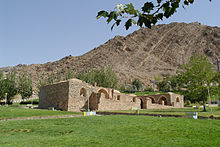Kuhbanan (Persian: كوهبنان)[a] is a city in the Central District of Kuhbanan County, Kerman province, Iran, serving as capital of both the county and the district.[4]
Kuhbanan
Persian: كوهبنان | |
|---|---|
City | |
 | |
| Coordinates: 31°24′36″N 56°16′57″E / 31.41000°N 56.28250°E[1] | |
| Country | Iran |
| Province | Kerman |
| County | Kuhbanan |
| District | Central |
| Population (2016)[2] | |
• Total | 10,761 |
| Time zone | UTC+3:30 (IRST) |

Etymology
editThe name Kūhbanān means "pistachio-tree mountain", from the Persian words kūh, meaning "mountain", and banān, which refers to the wild pistachio.[5]
History
editKuhbanan was described by the 10th-century writer al-Muqaddasi as a small town with two gates. The town's jameh mosque was by one of these gates. Outside the walled part of the city was a suburban area, where there were bathhouses and caravanserais. Beyond this suburban area, Kuhbanan was surrounded by farms and orchards that extended as far as the foot of the nearby mountains.[5]
Medieval Kuhbanan was renowned for its production of tutty, an impure oxide of zinc used as a salve for the eyes. As early as the 10th century, al-Muqaddasi listed tutty from Kuhbanan as one of the major exports of Kerman province. He wrote that it formed in finger-like "pipes", which were then purified by being roasted in long furnaces by the same mountainside where the ore was extracted. In the early 1200s, Yaqut al-Hamawi similarly described Kuhbanan, along with the nearby town of Behabad, as a major exporter of tutty. Marco Polo visited Kuhbinan, which he called Cobinan, in the 1300s, and provided a detailed description of the local tutty industry. Around the turn of the 20th century, the British traveler Percy Sykes witnessed the production of tutty in Kuhbanan; the process he described was essentially the same as that used hundreds of years earlier.[5]
Demographics
editPopulation
editAt the time of the 2006 National Census, the city's population was 10,112 in 2,623 households.[6] The following census in 2011 counted 11,093 people in 3,189 households.[7] The 2016 census measured the population of the city as 10,761 people in 3,296 households.[2]
See also
editNotes
editReferences
edit- ^ OpenStreetMap contributors (7 December 2024). "Kuhbanan, Kuhbanan County" (Map). OpenStreetMap (in Persian). Retrieved 7 December 2024.
- ^ a b Census of the Islamic Republic of Iran, 1395 (2016): Kerman Province. amar.org.ir (Report) (in Persian). The Statistical Center of Iran. Archived from the original (Excel) on 20 October 2020. Retrieved 19 December 2022.
- ^ Kuhbanan can be found at GEOnet Names Server, at this link, by opening the Advanced Search box, entering "-3072278" in the "Unique Feature Id" form, and clicking on "Search Database".
- ^ Aref, Mohammada Reza (25 April 1400) [Approved 25 November 1383]. Divisional reforms and changes in Kerman province. rc.majlis.ir (Report) (in Persian). Ministry of the Interior, Political-Defense Commission of the Government Board. Proposal 1.4.42.50870; Letter 58538/T26118H. Archived from the original on 14 April 2021. Retrieved 2 February 2024 – via Islamic Parliament Research Center of the Islamic Republic of Iran.
- ^ a b c Le Strange, Guy (1905). The Lands of the Eastern Caliphate: Mesopotamia, Persia, and Central Asia, from the Moslem Conquest to the Time of Timur. New York: Barnes & Noble, Inc. p. 309. OCLC 1044046.
- ^ Census of the Islamic Republic of Iran, 1385 (2006): Kerman Province. amar.org.ir (Report) (in Persian). The Statistical Center of Iran. Archived from the original (Excel) on 20 September 2011. Retrieved 25 September 2022.
- ^ Census of the Islamic Republic of Iran, 1390 (2011): Kerman Province. irandataportal.syr.edu (Report) (in Persian). The Statistical Center of Iran. Archived from the original (Excel) on 29 March 2023. Retrieved 19 December 2022 – via Iran Data Portal, Syracuse University.
